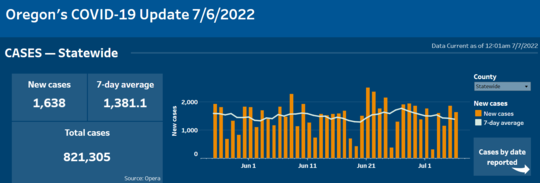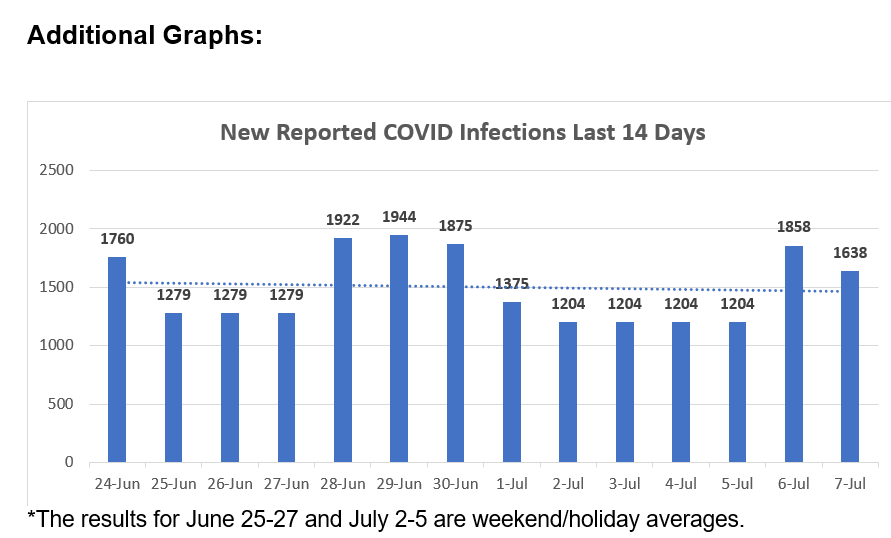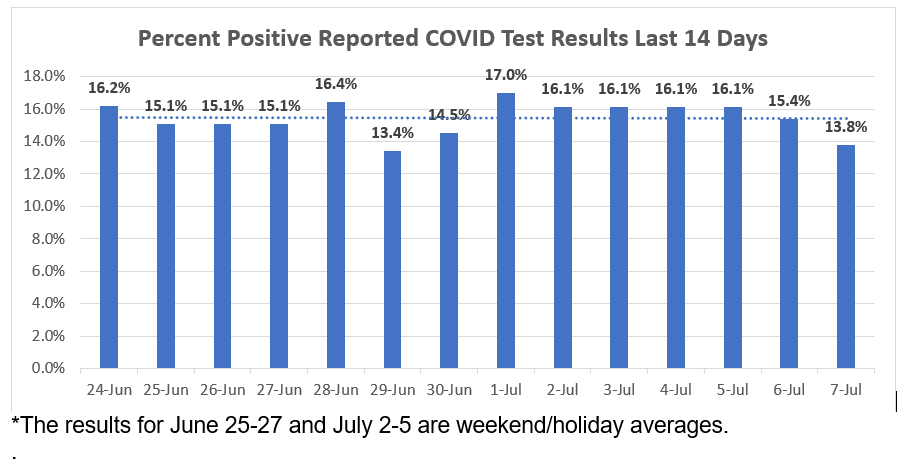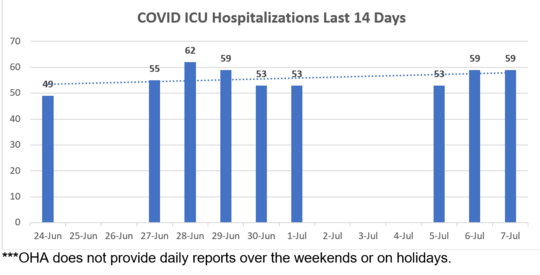|
July 8, 2022
Dear Neighbors and Friends,
I hope that you and your loved ones are doing well, staying healthy, and looking out for your neighbors and friends during this past week.
As I mentioned in the last newsletter, ‘tis the season for legislators to prepare for potential legislation in the next session by visiting a variety of programs and operations around the state to see them firsthand and understand their needs, challenges, and requests. It’s also a time for us to attend meetings with counterparts from around the country to learn about cutting-edge work on a variety of topics. Last time, I talked about work on occupational licensing. This past week I was able to engage with a number of legislative, congressional, and parliamentary colleagues who are working on modernizing our recycling systems and reducing our reliance on single-use plastics. I’ll talk more about that effort in the future.
In tonight’s newsletter you’ll see info about another work group that is just getting off the ground—focused on very large poultry operations. You’ll also find information about tomorrow’s constituent coffee and news about two ballot measures that appear to have qualified for the ballot.
On the COVID front, you’ll see more proof that the new Omicron variants remain stubbornly contagious, more so than was expected. The “cresting” of the current Omicron surge predicted in earlier models is not giving us the rapid declines that we saw in earlier surges. This has led OHSU to revise its forecast to show a slower process for us to get through this surge. You’ll see more about that in the OHSU forecast section below.
We can see from test reports and from wastewater analyses that many areas of the state remain at high risk for transmission. Though they may not be seriously ill, many people are having to take time off from work because they’ve tested positive and are contagious. Fourteen counties are now considered to be at High Risk, and the CDC is recommending particular caution in those areas.
This is actually a marked improvement from last week, when the number was 24 and not a single Oregon county was Low Risk.
There may be more good news coming. Statewide, we did see a decline in new infections last week, and severity fortunately remains relatively low, including our death rates. The vaccines appear to be doing their job. More on that in the various graphs, reports, and links in this week’s newsletter.
Until next time, please stay healthy and safe. And let me know if you have any questions or thoughts about anything in tonight’s newsletter.
Next Constituent Coffee TOMORROW, July 9th
Tomorrow, July 9th, will be our second in-person gathering since March 2022, with coffee and cookies, back at the Hollywood Senior Center, 1820 NE 40th Avenue (from 9 am to 10:30 am).
I received a request from a constituent who must limit her in-person contact to include a zoom component to the meeting, and I of course respect her situation. I’ve found that such hybrid meetings are tough for those who aren’t in the room, but we’ll do our best.
If you need to do the zoom option, you can register for it here.
In general, we'll continue to alternate between in-person and zoom, so the August meeting will be entirely on Zoom.
Hope to see you tomorrow!
Poultry CAFO Work Group Has Its First Meeting
Yes, it’s been a workgroup-heavy summer for me already this year, with workgroups and task forces on student success in higher education, addressing the shortfall in educator workforce, small-scale renewable energy projects, medical care in prisons, reducing solitary confinement, university governance, and more to come. Most or all of these will result in legislation in the 2023 session.
Yesterday was the first meeting of the workgroup looking into the rules and regulations around siting very large poultry-raising operations. I wrote about this a few weeks ago. We have several projects being proposed for the Willamette Valley. They are brought to the facility as chicks—approximately a million at a time--and are raised in the indoor facility until they are ready for slaughter. Neighbors are very concerned about health and environmental impacts. As a result, Senate Natural Resources Chair Jeff Golden has asked me to head up a work group to explore and better understand the potential problems. I have some familiarity with this problem from the time I was chairing Senate Environment and Natural Resources and had to deal with issues around dairy “CAFOs” (Concentrated Animal Feeding Operations).
We’ve put together a group that includes legislators from both parties, county commissioners, representatives of poultry and other natural resource industries, neighbors, and environmentalists, as well as a number of agency representatives. You can find the full list of participants on the workgroup website, which will contain a variety of resources over the course of the workgroup.
Yesterday’s meeting focused on the current approval process for poultry CAFOs, with a focus on air and water quality. Next meeting (July 27) will focus on land use (the use of prime agricultural land for this process) and the county’s role in the approval process. The third meeting (August 12) will focus on water supply. The fourth meeting (August 31st) will be devoted to hearing public comment. The final meeting (September 15) will be a time for workgroup members to share their final observations and conclusions.
Again, you can follow the work at the workgroup website.
The work group has generated some attention from the news media. The Capital Chronicle provides an overview of the problem and the process. Veteran reporter Dick Hughes covers the work group with a particular focus on my role in it for the Capital Insider.
Two Ballot Initiatives Appear Headed for the Ballot
It’s looking as if two initiatives that I’ve mentioned in past newsletters have garnered enough signatures to be on the Oregon ballot in November.
OPB reports that IP 14, the Legislative Accountability measure, definitely has more than enough signatures to qualify. This is the measure designed to prevent legislators from leaving the Capitol for extended periods of time in order to deny quorum and kill bills that otherwise had the votes to pass. You’ll remember that in 2020 this tactic was used to kill a compromise climate action bill, with virtually every other bill dying as collateral damage. The measure will not end walkouts per se, but it will make them less likely because it would bar any legislator with 10 or more unexcused absences from running for reelection. At this point polling shows this concept to be very popular with the voters.
The second measure also appears to be on track to qualifying, according to the Capital Chronicle. This is the measure that would take further steps towards gun violence prevention, which I’ve written about before. This grassroots effort, organized by clergy and others in the Lift Every Voice coalition, would limit the size of ammunition magazines and would require a permit to purchase firearms in the future. I want to thank everyone who stepped up, downloaded a petition, signed and got others to sign, and sent it in to the organizers in time. Fingers crossed that it will make it.
ON THE COVID FRONT

Weekly Data Report:
We’re now seeing mixed statewide results in the key COVID metrics. Reported infections and deaths have gone done, while test positivity and hospitalizations are rising.
- The number of reported infections is going down again. OHA reported 9,687 new cases of COVID-19 during the week of July 1-7 (vs. 10,793 the week before), a 7-day average of 1,384 per day (vs 1,542 the previous week). The number of new cases is again likely an undercount, as many people are using home tests to determine their infection status but are not reporting those results.
- Average test positivity for the last week was 15.9%, a slight increase from the previous week’s 15.1%. Again, this number skews high because it likely reflects a higher proportion of people showing COVID symptoms (and thus going in for a test, rather than self-testing).
- On Thursday there were 323 COVID-19-related hospitalizations, vs. 418 last Thursday. This is higher than was forecast in the last OHSU report; however, as you’ll see below, OHSU now predicts the number to continue to rise for another week. Again, many of these hospitalizations are not in and of themselves due to COVID—they include those who tested positive after having been admitted for other reasons.
- The number of COVID patients in Oregon’s ICUs was 59 on Thursday, an increase from last week’s 53. These are the most serious COVID infections.
- There were 26 reported COVID-19-related deaths during the last week, vs. 49 last week. Again, some of these are late-reports from earlier weeks.

Weekly County Report: 14 Now at High Risk, 15 at Medium Risk
OHA is no longer providing a weekly county report each Monday, but there are still ways to track this data. According to the CDC Daily Counter (updated each Thursday), fourteen Oregon counties are now at high risk of COVID transmission, a status that reflects both the number of new COVID cases and the number of people in hospital for COVID: Multnomah, Clackamas, Washington, Coos, Curry, Josephine, Jackson, Klamath, Lake, Malheur, Baker, Wallowa, Union, Umatilla. The CDC recommends that people wear masks in public indoor settings in those counties. This is actually an improvement over last week’s report, where 24 of the 36 counties registered as High Risk.
Here’s what the CDC recommends for this category: Stay up to date with COVID-19 vaccines. Get tested if you have symptoms. Wear a mask if you have symptoms, a positive test, or exposure to someone with COVID-19. Wear a mask on public transportation. You may choose to wear a mask at any time as an additional precaution to protect yourself and others. If you are at high risk for severe illness, consider wearing a mask indoors in public and taking additional precautions.
Fifteen Oregon counties have reported infection rates that place them in the Medium Risk category: Columbia, Clatsop, Tillamook, Marion, Polk, Lane, Douglas, Deschutes, Crook, Jefferson, Wasco, Morrow, Wheeler, Grant, and Gilliam. The remaining 7 Oregon counties (Yamhill, Lincoln, Linn, Hood River, Gilliam, Wheeler, and Harney) remain at Low Risk. Again, even this small number is a piece of good news: last week there were none at Low Risk.
Again, we must remember that these are only the tests results that have been reported. With the prevalence of home tests, there are certainly many more positive cases out there that have not been reported.
We can also track the test positivity rates for each county and the state as a whole at this dashboard. The test positivity rates reported this week show continued increases.
Among the reported cases, the statewide infection rate has gone up from 11.9% last week to 13.5% this week.
At 13.2%, Multnomah County is back to showing a decrease, slightly down from last week’s 13.8%.

This Week’s Wastewater Monitoring Report Shows an Increase in Number of Cities with Steady COVID Increases
With testing reports giving us just a fraction of infections out there, wastewater monitoring has become a more reliable indicator of the amount of virus in cities around the state. That report is updated each week.
This week’s report shows us that the following 9 cities (up from 3) are showing sustained increases: Portland, Hillsboro, Pendleton, Albany, Corvallis, Cottage Grove, Klamath Falls, Bend, and Sunriver.
Most cities surveyed continue to show a plateau of detected virus, but the increase in the number of sustained increases suggests that the current surge is not ending soon.
OHSU Forecast: We Will Continue to Feel the Effects of New Variants
The current OHSU Forecast Report, published yesterday, uses data provided by OHA and others that project how fast the virus may spread in the population and provides projections on possible outcomes, including infection rates and impacts on hospital capacity. The lead author is Dr. Peter Graven, Director of OHSU’s Office of Advanced Analytics.
It normally appears every two weeks. However, because of the increasing presence of the new BA.4 and BA.5 variants, last week’s forecast was postponed to this week to give them more time to better understand their full effects.
This forecast marks a change from the previous forecasts going back to April 8. It reflects the presence of the new BA.4 and BA.5 variants in Oregon, leading to much higher transmission. Though this is not matched by strong increases in severe COVID, we are seeing a higher level of COVID hospitalizations, including the number of those in intensive care, than was previously forecast. Having said that, the hospitalization and ICU numbers remain well below previous peaks.
OPB's Think Out Loud will feature an interview about the latest forecast with Dr. Graven on Monday at noon, repeated at 8 pm (also will be available online).
Here are key observations in this week’s report:
- As of July 6, 423 patients were in Oregon hospitals, a marked increase that started June 22.
- Test positivity has bounced upward in the last two weeks.
- Oregon Oregon’s cases levels are currently the 18th highest in the US.
- The number of tests has dropped from 104k the week of 5/15 to just 78k the week of 6/26.
- Wastewater data shows signs of increase.
- The BA.4 and BA.5 variants have shown sharp increases over the last two months. They are now the dominant strains in Oregon.
- BA4/5 began growth in early May and is expected to peak in middle of July before declining. Strains prior to BA4/5 have already begun receding.
- As of July 6, 10% of occupied ICU beds had COVID patients in them statewide. This is an increase from the 4% reported in the last forecast report.
- As of July 5, 16 children were in Oregon hospitals.
- The forecast has undergone significant modifications to accommodate the BA.4/BA.5 variants. The strains, with an immune "escape rate" of 15%, can infect people who have recovered from a prior infection.
- The number of people in Oregon hospitals is expected to peak July 12 at 479 (yesterday’s reported number was just 423).
- Again, a significant share of hospitalizations are expected to be incidental (i.e., not primarily for COVID).
- The effects on hospital staffing are likely to remain high in July as BA.4/BA.5 infections remain high.
Additional COVID Updates and Links
- The FDA has given authorization for pharmacists to prescribe Paxlovid to patients under certain circumstances.
- Should you get your booster now or wait till the fall? Here are thoughts from Dr. Wen.
- According to an article in JAMA Open Network, vaccines have prevented 200,000 COVID deaths. Here's more.
- A recent drug trial showed the drug sabizabulin more than doubling the survival rates of extremely ill COVID patients by an impressive 55%.
- JAMA reports that in 2020 COVID was the third leading direct cause of death for Americans, following heart disease and cancer. It may also have contributed indirectly to a number of other deaths.
- The CDC now has a model called “NOWCAST” that tracks COVID variants over time. Here's a graph showing the different rates for March to July of this year.
- Johns Hopkins has released a report and a map showing COVID mortality rates by state. The lowest is Vermont, followed by Washington, Alaska, Maine, and Oregon. Mississippi and Arizona have the highest death rates.
- As we await a potential reformulated COVID booster for the fall, a number of unanswered questions remain. Here are some from a senior researcher at Johns Hopkins.
- Despite the rising number of COVID hospitalizations, OHA has announced that it will only be releasing updated numbers once a week. This appears to be in line with how other states are handling the reporting and reflects the thinking that the number of hospitalizations strictly for COVID alone has peaked.





Here again are some COVID resources that you will find useful:
If the above links are not providing you with answers to your questions or directing you to the help that you need, please consider me and my office to be a resource. We’ll do our best to assist you or steer you in the right direction.
Want to See Past Newsletters?
If there was COVID-related information in a past newsletter that you want to go back to, but find you’ve deleted it, you can always go to my legislative website (senatordembrow.com), click on “News and Information,” and you’ll find them all there. Also, if someone forwarded you this newsletter and you’d like to get it directly, you can sign up for it there.
Best,
 Senator Michael Dembrow
District 23
email: Sen.MichaelDembrow@oregonlegislature.gov
web: www.senatordembrow.com
phone: 503-281-0608
mail: 900 Court St NE, S-407, Salem, OR, 97301
|